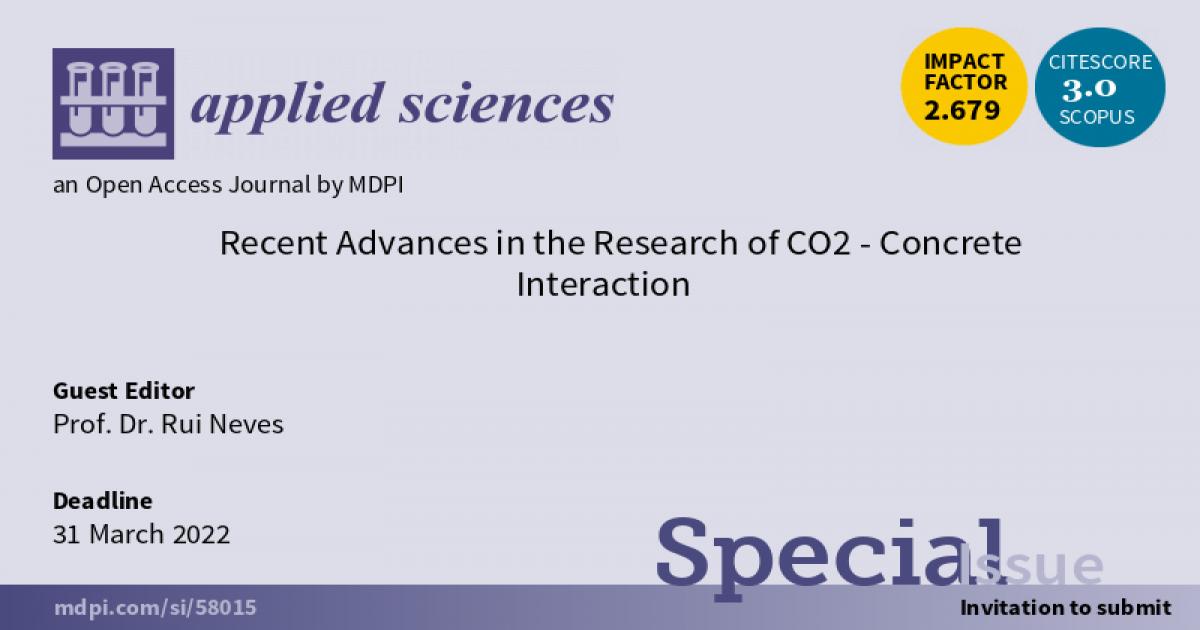- 2.5Impact Factor
- 5.5CiteScore
- 20 daysTime to First Decision
Recent Advances in the Research of CO2-Concrete Interaction
This special issue belongs to the section “Civil Engineering“.
Special Issue Information
Dear Colleagues,
Concrete carbonation is a research topic that has existed for a very long time, but which is still receiving plenty of attention. The first investigation on concrete carbonation dates from the first decade of the twentieth century, and a lot has been achieved in the field so far. Despite all the progress reached concerning the durability of reinforced concrete structures, though, which is the subject to which most research efforts have been devoted, there are still some gaps to bridge, such as probabilistic service life design and life cycle analysis. Meanwhile, cement-based concrete has gained a reputation as a pollutant material. On the other hand, part of the research focus has shifted to studying concrete as a CO2-sequestrating material. Still within the frame of environmental concerns, low-carbon binders and even cement-free concrete have been tried out. All this has opened up new fields in concrete carbonation research. This Special Issue of Applied Sciences constitutes a way to disseminate results and findings from reviews, original studies, and experimental programs addressing probabilistic service life design and life cycle assessment of concrete, encompassing carbonation, as well as on the ability of concrete for CO2 sequestration and on carbonation of concrete with unconventional constituents, in particular, with alternative or “new-generation” binders.
Prof. Rui Neves
Guest Editor
Manuscript Submission Information
Manuscripts should be submitted online at www.mdpi.com by registering and logging in to this website. Once you are registered, click here to go to the submission form. Manuscripts can be submitted until the deadline. All submissions that pass pre-check are peer-reviewed. Accepted papers will be published continuously in the journal (as soon as accepted) and will be listed together on the special issue website. Research articles, review articles as well as short communications are invited. For planned papers, a title and short abstract (about 250 words) can be sent to the Editorial Office for assessment.
Submitted manuscripts should not have been published previously, nor be under consideration for publication elsewhere (except conference proceedings papers). All manuscripts are thoroughly refereed through a single-blind peer-review process. A guide for authors and other relevant information for submission of manuscripts is available on the Instructions for Authors page. Applied Sciences is an international peer-reviewed open access semimonthly journal published by MDPI.
Please visit the Instructions for Authors page before submitting a manuscript. The Article Processing Charge (APC) for publication in this open access journal is 2400 CHF (Swiss Francs). Submitted papers should be well formatted and use good English. Authors may use MDPI's English editing service prior to publication or during author revisions.
Keywords
- concrete carbonation
- alkali-activated binders
- geopolymer concrete
- CO2 sequestration
- recycled aggregate concrete
- service life design
- life cycle analysis
- low binder concrete

Benefits of Publishing in a Special Issue
- Ease of navigation: Grouping papers by topic helps scholars navigate broad scope journals more efficiently.
- Greater discoverability: Special Issues support the reach and impact of scientific research. Articles in Special Issues are more discoverable and cited more frequently.
- Expansion of research network: Special Issues facilitate connections among authors, fostering scientific collaborations.
- External promotion: Articles in Special Issues are often promoted through the journal's social media, increasing their visibility.
- e-Book format: Special Issues with more than 10 articles can be published as dedicated e-books, ensuring wide and rapid dissemination.

